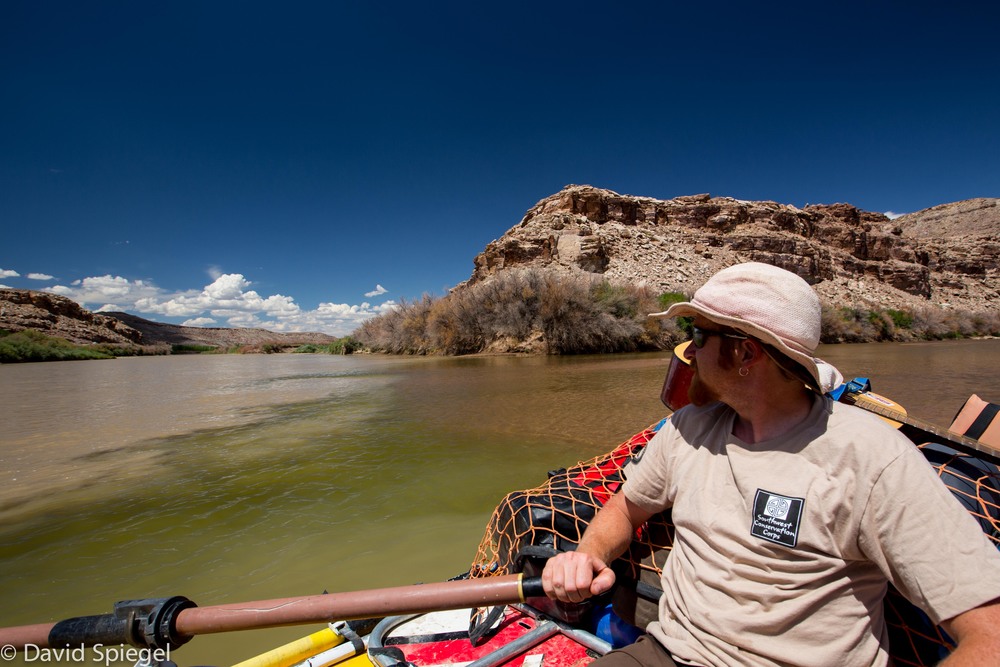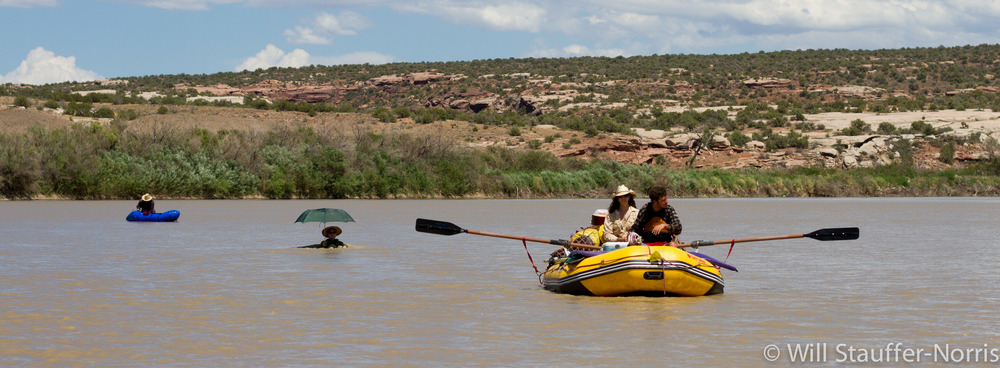Watershed Habitat Restoration- Growing Collaborations Repair the Riparian Landscape
At Westwater Ranger Station, we are joined by Mike Wight of the Southwest Conservation Corps. Mike’s here to float with us past the Dolores River confluence, some 32 miles downstream, and to outreach the work of a collaborative initiative; the Dolores River Restoration Partnership.
Two days later, after emerging from Westwater Canyon unscathed, we approach the confluence with the Dolores. Mike explains that the river originates in the beautiful San Juan Mountains in Southwest Colorado, flowing from the Alpine vistas of Lizard Head Pass through desert canyons to Utah where it meets the Colorado River near Historic Dewey Bridge, now just a couple miles downstream. For recreationists, the Dolores offers one of the country’s longest wilderness floats; 170 miles of whitewater and beauty- when it flows. “It’s an amazing float if you get the chance, and the transition from forest to desert is really unique” says Mike. He goes on to discuss how the stretch of the river below McPhee Reservoir (like many rivers in the west) is impacted by tamarisk and other invasive plants that adversely affect the diversity and function of riparian (river-side) habitat. Mike notes that in Colorado, only 2% of the land is wetland and riparian habitat, yet 80% of wildlife depends on this resource. Tamarisk trees, in particular, out-compete native vegetation; reduce the diversity of wildlife habitat; increase the risk of wildfire intensity and spread; armor river banks; increase soil salinity; and decrease access for wildlife and recreationists to the river. “Invasives are an issue throughout the entire Colorado Basin” explains Wight “and one that’s beginning to be addressed at a watershed-scope”.

At the Dolores/Colorado River confluence
To mitigate the growing impacts of invasive vegetation, a group of stakeholders initiated the Dolores River Restoration Partnership (DRRP) in 2009. A shared vision was developed for “a watershed that is dominated by native vegetation, where the threats from tamarisk and other associated invasive species have been mitigated and the riparian areas of the watershed continue to become more naturally functioning, self-sustaining, diverse, and resilient over time.” As a public/private collaboration, the DRRP shares a common set of goals and principles for restoring the riparian corridor of the Dolores River. Partners make collective decisions of how to prioritize, fund, plan, implement, outreach, and monitor habitat restoration efforts. Collaboration and shared decision making across public and private land parcels is necessary to achieve partnership goals of restoring health to streamside habitat. The DRRP has been so effective as to be recognized for two-years in a row as a model for the Department of the Interior’s Americas Great Outdoors River Initiative. Trust, good working relationships, and shared goals for a healthy river tie the collaboration together to provide the foundation from which it works.
“Ok, well that’s a mouthful.” Says Mike as he takes a breath and straightens out the boat, “You’re probably wondering where I fit into all of this…” He goes on to explain that the partnership is made up of local, state, federal agencies, not-for profit organizations, landowners, foundations, local businesses, volunteers, and conservation corps. It’s an excellent example of collaborative conservation with multiple outcomes.
Implementation of project work utilizes local contractors and conservation corps programs which draw on young adults to engage in restoration efforts while learning important job skills. Corps programs are built on the legacy of the post-depression Civilian Conservation Corps to engage citizens in resource protection, conservation, and create jobs. As the Corps River Restoration Director, Mike directs the collaborative work of three corps programs within the Partnership. “It’s a ton of grueling work to treat the invasives along the river, especially in remote locations, but our crews are great for that” says Mike. The Southwest Conservation Corps (Durango, CO), Western Colorado Conservation Corps (Grand Junction, CO), and Canyon Country Youth Corps (Monticello, UT) train together each spring and fall for two month seasons tackling tamarisk with chain saws and completing associate restoration activities. The typical crew members are men and women 18-26 years old, interested in the outdoors, looking for an adventure, a new skill, and/or conservation experience. Mike goes on to say, “The partnership and the corps believe in recruiting diverse members from the local area to create opportunities to keep the conservation ethic, river stewardship, and economic boost in the communities surrounding these resources”. Members receive important job skills, training, and education around the importance of river systems while gaining experience, teamwork, strength and exposure to land management. They finish their experience with an AmeriCorps Education Award that can be used for college, trade school or to pay student loans.
“The Partnership has provided a great opportunity for the involved corps to meet their missions creating opportunities for and empowering young adults and it is really valuable that the DRRP is committed to both ecological and social outcomes in this multi-year project” says Mike. Since the partnership began its focus on the Dolores, over 850 acres of tamarisk throughout the corridor have been treated. 150 positions for leaders, members and interns have been created to complete over 50,000 hours of project work! In addition, members have earned over $77,000 in Education Awards; helping them advance their career goals. Many members have moved up to being crew leaders, interns or working in public lands management, "which is the true intent of corps programs, to jump start conservation careers" states Mike as he beaches the raft on a sandbar just below the confluence.

Floating below Westwater Canyon
“I wish I could show you guys some of the project sites we’ve been working in!” Mike says. It’s really cool to see the native plants rebound after the tamarisk is removed, and in places we’ve got planted cottonwoods established, which is awesome to see, and no small feat in the desert!”
As Zak dives in to the confluence, live-testing the temperature difference between the Dolores and the Colorado, Mike explains that the initiative on the Dolores is being echoed in many Colorado River tributaries. In the last three years, collaborative partnerships have been building momentum to face issues of invasive species on rivers. Project work with corps programs is being implemented on the Verde in Arizona (Verde Watershed Restoration Coalition), the Escalante river in Utah (Escalante River Watershed Partnership), the Virgin in Nevada (Virgin River Southwest Willow Flycatcher Collaborative), and soon, on the Gila in Western Arizona (Gila Watershed Partnership). While some of the species of concern for these groups vary (Russian Olive, Tree of Heaven, Giant Reed, etc.), the issues are much the same- reduced quality of river-side wildlife habitat, access, bank stabilization and more. With the extent of the problem, it creates a situation dependent on collaborative efforts across boundaries, which these emerging partnerships are poised to address.
For more information on partnerships and corps programs, visit www.corpsriverrestoration.org


